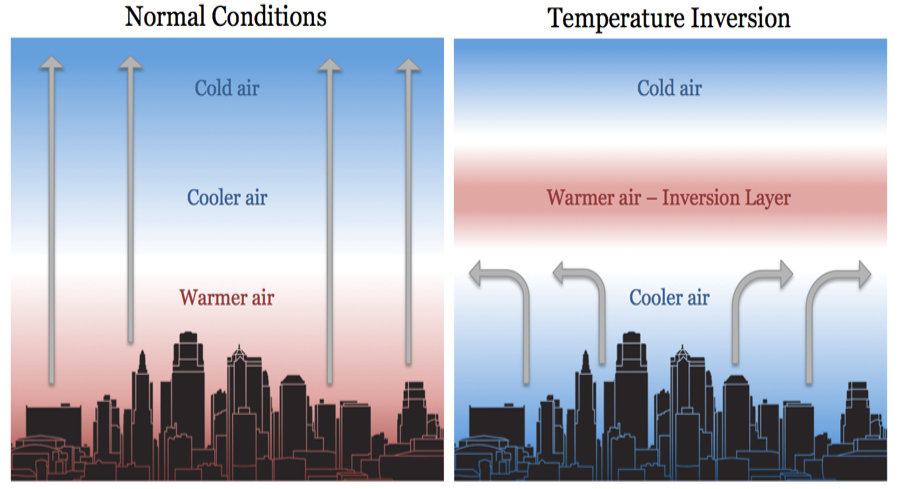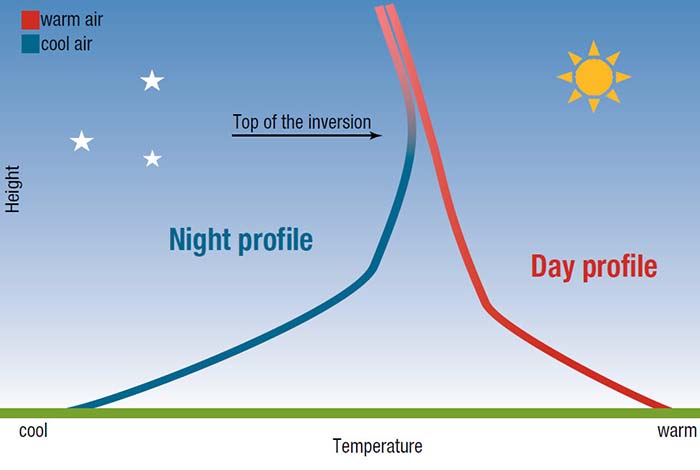While these weather phenomena are natural unavoidable occurrences understanding temperature inversions helps clarify the cause of air pollution episodes and reveals just how closely air quality and weather are linked. It is a reversal of the normal behavior of temperature in the troposphere.
The temperature inversion can be maintained in a stable water column since it is density-compensated by a corresponding salinity increase with depth throughout the inversion layer.

. Also it is the contradictory situation of the normal situation. This means sounds can travel further and sound much louder than it really is. Inversion forms a division between the atmospheric layers.
Places that experience temperature inversion also include the ocean waters when the water temperature increases with depth rather than decreasing. This differs from normal tropospheric conditions in which temperature decreases with height from the surface. An unstable layer of air.
It can be strong in regions with high mountains or deep valleys also. Strong wind shears often occur across temperature inversion layers which can generate turbulence. A classic example is when colder air settles into mountain valleys during times of stable high-pressure weather conditions.
There are several ways they can be created which include. Terrestrial radiation on a clear relatively still night. What aircraft inspections are required for rental aircraft that are also used for flight instruction.
Because of the very high frequency of the temperature inversions in the Arctic in the annual. The most frequent type of ground or surface based temperature inversion is that which is produced by. 1 High pressure subsidence 2 WAA in the middle levels of the troposphere 3 Radiational cooling of the earths surface 4 Warm air flowing over a large cold water body.
A Annual condition and 100-hour inspections. Inversion is most likely to occur during a. Inversions are a ubiquitous feature in the vertical structure of.
Surface-based temperature inversions in the troposphere are one of the main features of the Arctic climate particularly in the low-sun or no-sun periods. What feature is associated with a temperature inversion. Occasionally temperature stratification within the surface layer can be inverted ie cool water lies above warmer water.
The most common type of nonstandard refraction is associated with a sharp vertical gradient in the. C Chinook winds on mountain slopes. What feature is associated with a temperature inversion.
Under normal conditions air temperature usually decreases with height. A A stable layer of air. An increase in temperature as altitude is increased.
Temperature inversion also called thermal inversion a reversal of the normal behaviour of temperature in the troposphere the region of the atmosphere nearest Earths surface in which a layer of cool air at the surface is overlain by a layer of warmer air. 2 Sound Amplification. Thus the existence of warm air above and cold air below reverses the normal lapse rate decrease of temperature with increasing height.
It is caused in stac atmospheric conditions while some times it occurs due to horizontal or vertical movement of air. Temperature inversions have a profound effect on our air quality especially in todays urban environment. The warm air is pushed up by the cold polar air and thus the warm air overlies the cold air because it is lighter than the cold air.
B Biannual condition and 100-hour inspections. The Inversion Courtesy of Meteorologist Jeff Haby. In other words the vertical temperature gets inverted during temperature inversion.
Movement of air is the cause of heat transfer that takes place in the troposphere. Which is the cor. The most frequent type of ground or surface based temperature inversion is that which is produced by a terrestrial radiation on a clear relatively still night b warm air being lifted rapidly aloft in the vicinity of mountainous terrain c the movement of colder air under warm air or the movement of warm air over cold air.
It as acts as a giant reflective ceiling under which all sound generated is refracted down. B An unstable layer of air. An inversion is an increase of temperature with height.
A stable layer of air. This condition opposite to normal vertical distribution of temperature is known as Temperature Inversion. When moisture andor temperature inversions are present the vertical gradients of water vapor pressure temperature and the index of refraction differ from their standard atmosphere values and nonstandard refraction also known as anomalous propagation can occur.
Near the ground on clear cool nights when wind is light. Temperature inversions are observed when the air temperature increases with height. This kind of temperature inversion is very strong in the middle and higher latitudes.
What feature is associated with a temperature inversion. Temperature inversion is usually of short. A temperature inversion is characterized by air.
Besides there are certain ideal conditions for temperature inversion that include stable and calm air clear skies and long nights are the factors that give rise to temperature inversion. A temperature inversion also has the effect of amplifying sounds below it. By signing up youll get thousands of step-by-step solutions to your homework.
Under this meteorological phenomenon a layer of warm air lies over the cold air layer. Under normal weather conditions the air temperature typically decreases with height. Effects of Temperature Inversion.
It refers to the condition where the cool layer of air is overridden by the warm layer of air above. Colder more dense air pushes under the warmer less dense air.

What Feature Is Associated With A Temperature Inversion Lisbdnet Com

What Feature Is Associated With A Temperature Inversion Lisbdnet Com

0 Comments